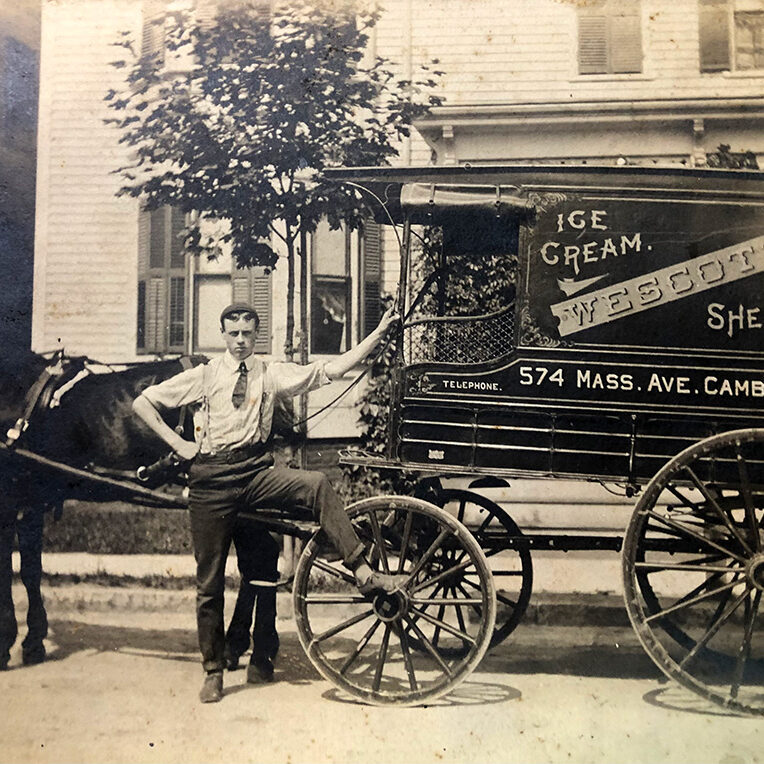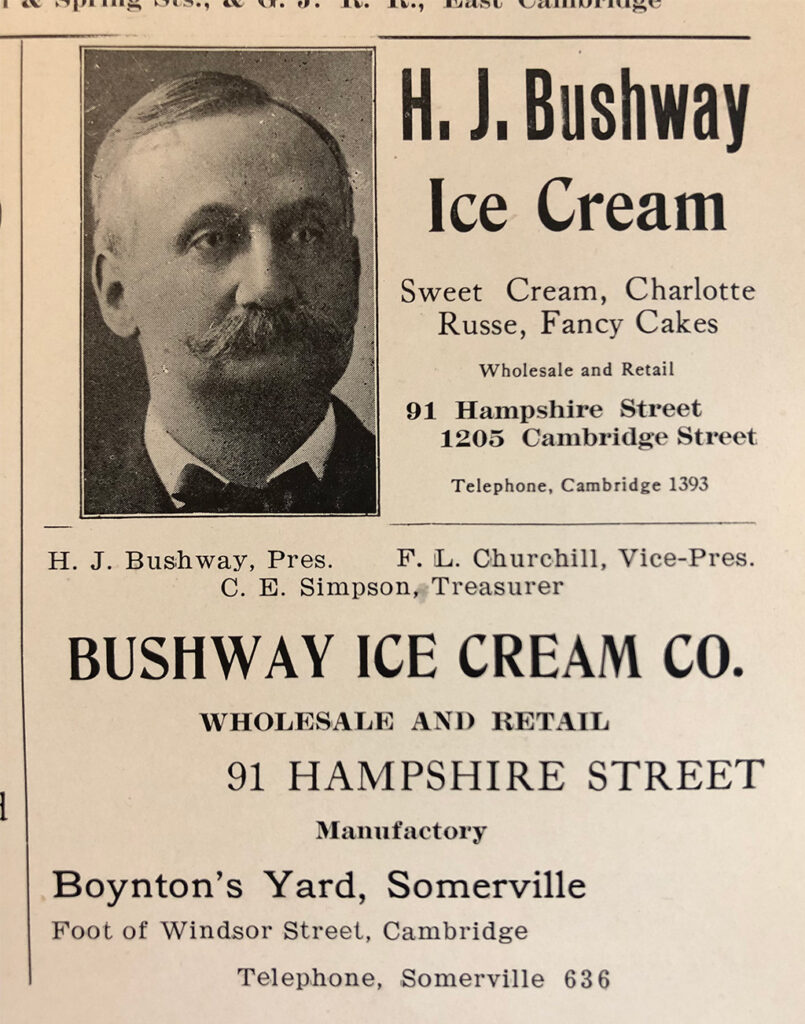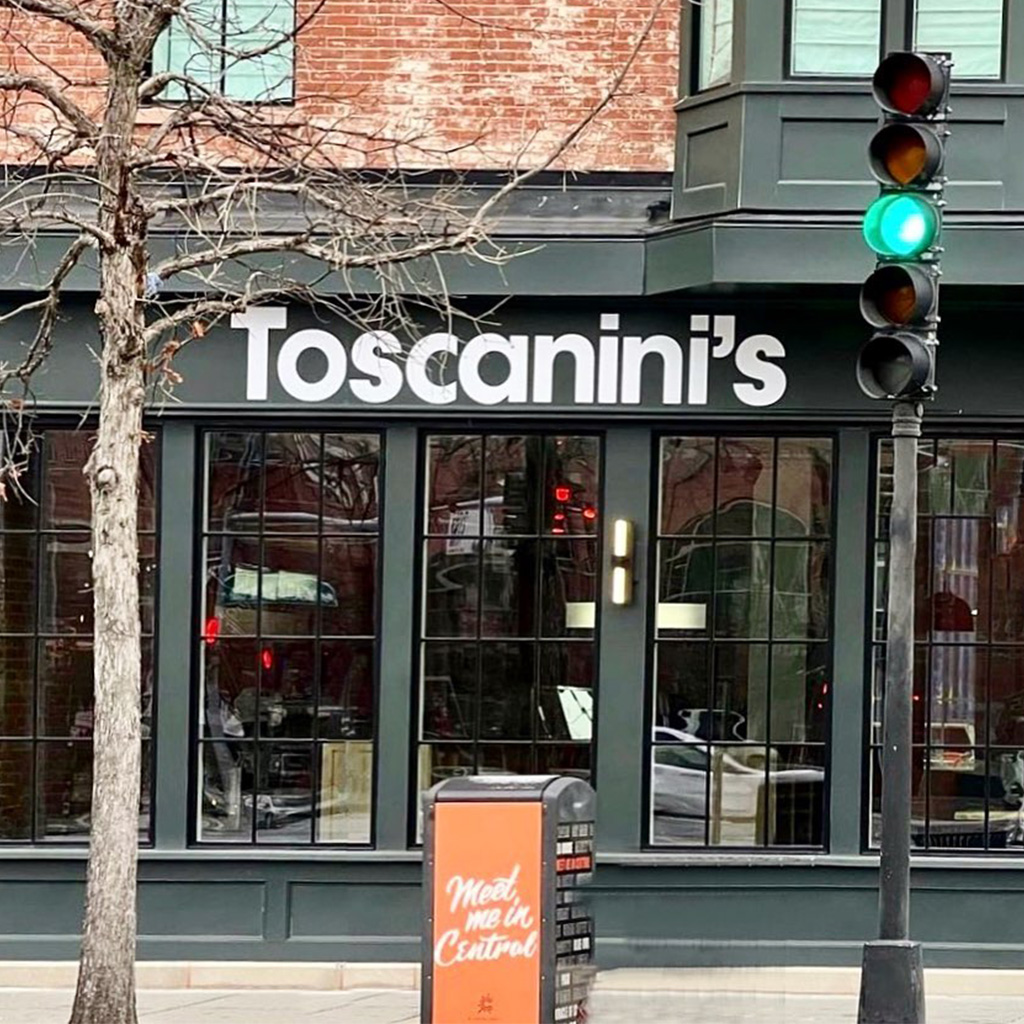
Ice Cream has a cool local history, and it begins with the ice itself, carved from our local ponds
Above image: A driver poses with his horse and ice cream cart in Cambridge in 1902. (Photo: The Photo Angel)
President Ronald Regan declared the third Sunday in July to be National Ice Cream Day in 1984. A nod to the importance of the dairy industry, Regan’s proclamation also recognized that Americans consume more ice cream per year than residents of any other country – an average of 23 gallons per person per year. As early as the 1840s, residents of Cambridge could visit several local restaurants to cool off with an ice cream on a hot day. A June 1846 issue of The Cambridge Chronicle suggested that customers stop at G.A. Neal’s Saloon on Main Street, where they “will find the best quality of Soda, Ice Cream, and every cooling element.”
Ice cream has a long history in the Cambridge area; a local Boston merchant, Frederic Tudor, revolutionized the way not only Americans, but people worldwide, eat and drink. From the 1830s to 1890s, the Tudor Ice Co. harvested ice from Walden Pond, Fresh Pond and other lakes in New England and shipped it to the American south and the Caribbean, Europe and India. As an ice sales technique, Tudor demonstrated home-style ice cream making all over the world. Ice cream and chilled beverages became summertime staples, and the presence of a dependable ice supply made it possible to deliver fresh meat, seafood and dairy products without them spoiling.
In Cambridge, ice cream was first served at high-end restaurants and hotels. Once it became a commodity, ice cream was made here by companies such as White House Ice Cream and the General Ice Cream Co. In Charlestown, there was the Hood Creamery. Cambridge even had ice cream cone manufacturers, most notably the Harvard Ice Cream Cone Co., which opened in 1910 in Central Square.
Once the mechanical ice cream maker and the soda fountain machine were invented, ice cream parlors such as Boston’s Bailey’s, which opened in 1876, became community meeting places. In the late 19th and early 20th centuries, full-fledged restaurant dining was a rare treat, especially for Cantabrigians from the working class, but coffee shops and ice cream parlors provided a place for even those of modest means to enjoy a drink or a snack, and to gather to share news and stories after work or on a weekend afternoon. Local merchants also took their business on the road, selling their ice cream from a horse and cart that would travel around the city (the predecessor of today’s ice cream truck).

Until the early 20th century, when commercial refrigerators were adapted for home use, ice cream was a treat enjoyed almost exclusively at public venues. With the advent of large grocery stores with frozen food sections, and as families began to buy individual refrigerators and freezers, ice cream could be enjoyed at home. But even as the ability to buy and eat ice cream at one’s own house became possible, ice cream shops continued to be popular places to gather, eat and socialize.
Another industry for which Cambridge is famous is candy making, and local ice cream makers have been eager to pair these two treats. Somerville’s Steve Herrell was introduced to the Heath Bar in the 1960s. He fell in love with the flavor and thought it would make an excellent addition to ice cream. When he opened his Steve’s Ice cream shop in 1973, instead of having premade flavors, Steve had his staff mix freshly made ice cream with candy or other confections based on customer requests. He called the toppings “smoosh-ins” and trademarked the name. Later chains took the smoosh-in concept and applied it to their own operations, creating a whole industry around it. Joe Crugnale, who bought the company in 1977, even claims that Ben & Jerry’s was inspired by Steve’s model, as co-founder Ben Cohen visited often as a customer, photographing and inquiring about the shop’s methods.

Steve’s paved the way for the independent gourmet ice cream companies in Cambridge today, including J.P. Licks and of course Toscanini’s, whose owner Gus Rancatore apprenticed with Steve Herrell before he began his own business. As the ethnic makeup of Cambridge has shifted over the past century, ice cream has been a means through which a variety of ethnic groups have shared their culinary traditions with their neighbors. From Italian gelato to Japanese mochi ice cream, many ethnicities have adapted this treat to reflect their unique heritage. Check out this recent article for suggestions of local ice cream shops where you can beat the heat and enjoy a combination of old and new flavors for National Ice Cream Day on July 16.
Beth Folsom is programs manager for History Cambridge.
This article was originally published in our “Did You Know?” column in Cambridge Day.

